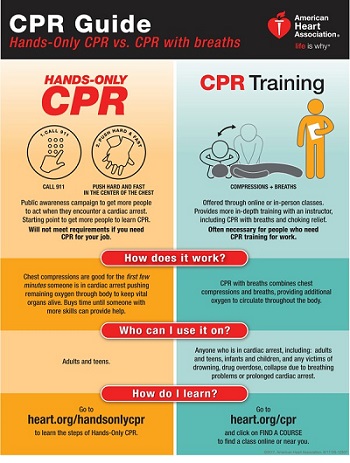'You Can Do No Harm By Helping' -- AHA Advises Compression-Only CPR

STATEN ISLAND, N.Y. -- When a person is in cardiac arrest, anything is better than nothing.
The American Heart Association wants the public to know that, as inexperienced bystanders, you can do no harm by helping.
The AHA just updated its guidelines, urging the nation's 911 dispatchers to instruct bystanders to use a compression-only technique to assist adults experiencing cardiac arrest, instead of the adding breaths to the treatment.
"The advantage to lay rescuers is it's easier, and they have more confidence in at least attempting,'' said Dr. Karl Kern, chairman of the American Heart Association, in a video explaining the 2017 Focused Updates on Adult and Pediatric Basic Life Support and Cardiopulmonary Resuscitation Quality, released last month. "The more they attempt, the more people that are going to be saved. "
When someone has a cardiac arrest, their survival depends on immediately getting CPR from someone nearby, said Kern, who is a professor of medicine at the University of Arizona College of Medicine-Tucson's Sarver Heart Center.
In fact, CPR performed in the first few minutes of cardiac arrest can double or triple the chance of survival, the AHA says. Currently, almost 90 percent of people who suffer out-of-hospital cardiac arrests die.
Giving compression-only instruction to bystanders encourages them to get involved, said Sarah Gillen, a CPR instructor and a member of the regional faculty of the AHA.
"There's always that hesitancy,'' she said. "They're afraid they can do harm, and that's just not the case. If someone is in cardiac arrest, they are basically dead. Anything you do is improving the situation.''
Mouth-to-mouth breathing discourages some from getting involved, Gillen said, but noted that research suggests it's not immediately necessary in adult cardiac arrest situations.
"We just want to remove those barriers for people wanting to help,'' she said. "You won't be putting yourself in harm's way by doing chest compressions. It's easy to find the spot. Place the heel of your hand in the center of the chest and push. That's all you've got to do.''
When adults experience cardiac arrest, there is usually residual oxygen in the lungs that will last until paramedics arrive, the AHA has said. Compressions without breaths are critical in the first minutes of arrest, Gillen stressed.
The AHA seeks to double the national cardiac arrest survival rate by the year 2020. According to the AHA, each year, more than 350,000 out-of-hospital cardiac arrests occur in the U.S.
New York City's survival rate is less than 10 percent, slightly lower than the national average, despite the fact that New York 911 dispatchers do give compression-only instruction, along with about 50 percent of dispatchers nationally.
That data suggests that New Yorkers need to step up, Gillen said.
"In New York, we need to get out there and do it,'' she said. "Ultimately, we need to eliminate that fear factor. There's no getting it wrong.''
Having a dispatcher walk a bystander through the process is a huge help, AHA spokespeople say. "This is not something you are doing every day, and having a knowledgeable professional walk you through it will remove that hesitancy. Sometimes you just need someone to tell you 'do this now.'''
With children, the situation is a bit different, Dr. Kern and Gillen said. When children go into cardiac arrest, often a lack of oxygen is to blame; therefore, breaths are more critical early in the process, the said.
"For children or infants, typically it's a breathing or respiratory emergency,'' Gillen said. "By the time they ultimately go into cardiac arrest, they've already depleted the oxygen from their lungs.'' Even then, "something is better than nothing,'' she said, so compression-only will still help if a bystander is reluctant to administer breaths. "I do think there's a different comfort level if it's a child, especially your own. You'll be less hesitant to put your mouth on the mouth of a child.''
There's also reluctance on the part of men when the victim is a woman, Gillen said, strongly urging men to ignore their initial disinclination.
"I've met a lot of female survivors,'' she said. "And they have no problem with the fact that someone tore open their shirt or did compressions on their chest. They're very happy with that.''
The AHA guidelines, which are used to train 22 million caregivers worldwide, were last updated in 2015 and have traditionally been updated about every five years. But, the AHA has recently transitioned to a continuous evaluation process, bringing updates more often.
Gaining full CPR certification takes about four hours, Gillen said. To find a local CPR training session, or find more CPR resources, visit heart.org.
Story Credit: http://www.silive.com/healthfit/index.ssf/2017/12/you_can_do_no_harm_by_helping_--_aha_advises_compression-only_cpr.html


